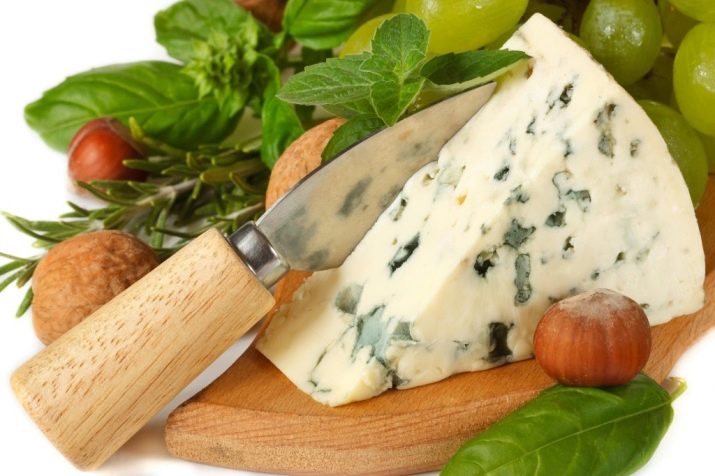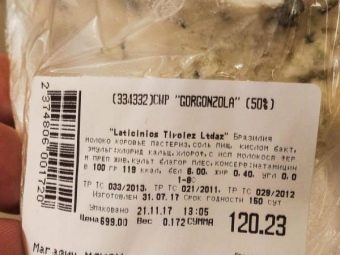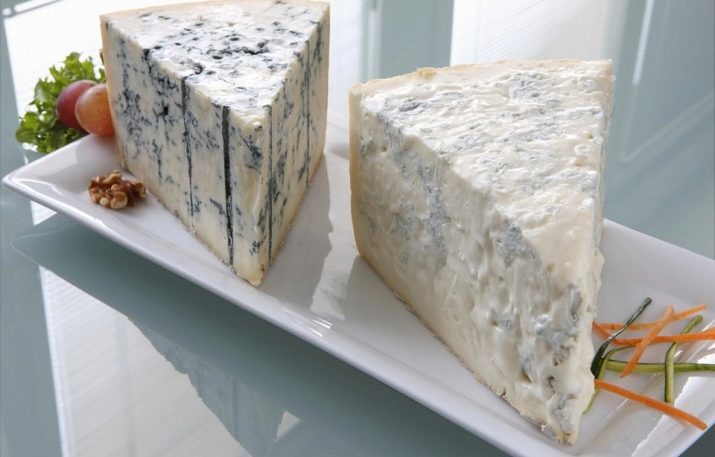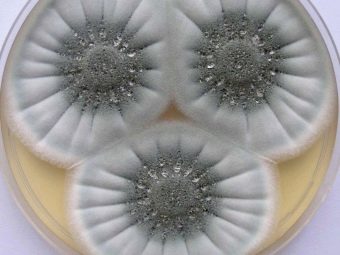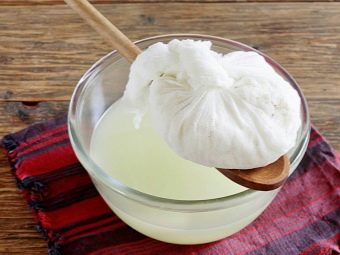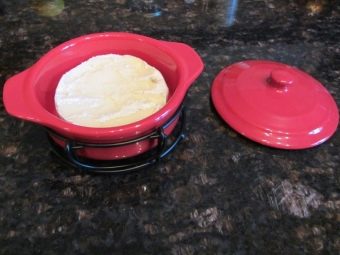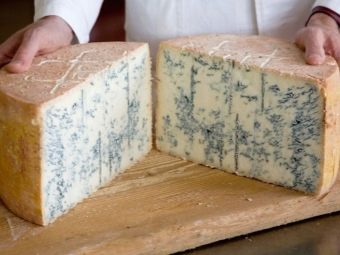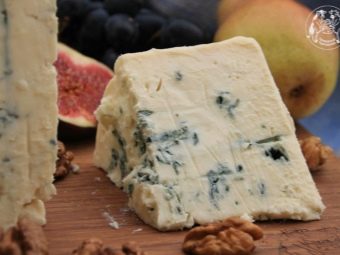Gorgonzola cheese: description, types and advice on how to eat
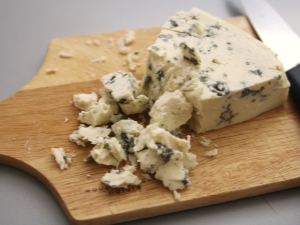
Gorgonzola is the most famous Italian cheese.Its rich taste combined with spicy notes fell in love with anyone who has ever tried this variety. Thanks to his mysterious creation story, he aroused the interest of many people.
Until now, the regions of Italy argue for the right to be considered the historical birthplace of this product. In fact, it doesn’t matter where they cooked it, much more interesting how. Gorgonzola looks great as part of a cheese plate, and is also used as a separate ingredient for the preparation of many dishes.
What it is?
Many people are very interested in the history of cooking this cheese. Disputes about the specific place and time of product creation led to the emergence of various legends about the cheese making business. According to one version for the first time Gorgonzola received in 879, not far from Milan. Others claim that cheese comes from the small town of Valsassina. This version is justified only by the presence of a large number of caves, where the temperature is about 10 degrees - ideal conditions for the ripening of cheeses.
The most incredible story of the discovery of varieties with blue mold is as follows. The boy in love was in such a hurry to meet his lover that he decided to leave his cheese-making work until tomorrow. Returning in the morning, he had to hide his absence and failure to do the work. For this, he added fresh milk to yesterday’s curd mix.
After a couple of weeks, he found blue streaks on the finished product, which scared him. But when he tried cheese, he realized that it was a discovery! After this story, prepare the blue cheese began in almost all areas of Italy. The first regions where it was possible to find and taste such cheese were Lombardy and Piedmont. But here it was prepared less often than other varieties. Later the cities of Pavia, Como, Navariya and Milan joined the matter.
Journey around the world Gorgonzola cheese began in the XX century. More than 20 thousand tons were exported to France, Germany and England. True, the British preferred a soft, slightly spicy white-colored Gorgonzola, while German and French residents bought tart blue curdled double-coated cheese. After the war, specialists developed a new recipe for making cheese using the “single cladding” method. This technology was much cheaper, more hygienic and, most importantly, more qualitative.
They built cheese factories on the banks of the river Po. In the late 1970s, small factories had to close due to the financial crisis. Therefore, at that time a decision was made, where the regions were appointed, which received the right to manufacture the Gorgonzola.
Surprisingly, but today there are only 30 cheese-makers, which produce the original Gorgonzola cheese. 45% of the output falls on the city of Navar, 22% on Pavia and 15% on Milan.
The cooking method has long been automated. It is a special process in which salted goat or cow's milk is used. The next step is to layering - a liquid rennet is added to the mixture. All this happens at temperatures above 30 degrees.
The most important is the introduction into the curd mass of mold fungi Penicillium glaucum or Penicillium roqueforti. Next, the resulting clot is sent to special cylindrical vessels, at the bottom of which spread natural fabric. To get rid of excess serum, the form must often be turned.
In order for Gorgonzola to acquire its unique taste, the cheese head should be rubbed with a mixture of sea salt. After that you can put it in a warm place with the humidity set for proper ripening. After a week, you can check the cheese for taste and texture. If the quality meets the standards, the cheese is pierced with special long knitting needles to form breathable veins and placed in a cool place: it is in these conditions that the blue mold will develop.
It takes about 60 days to ripen the soft Gorgonzola species, and spicy, from 4 months. Distinguish genuine Italian Gorgonzola can be on the label "G" on the packaging foil. In the manufacture of dairy product, cheese makers do not resort to the use of additional components and preservatives. Strict control of production and pasteurization of milk allows you to fully preserve the taste, thereby making the product safe.
The energy value of 100 g of Gorgonzola is quite high - 315 kilocalories. The number of carbohydrates is almost zero, which makes this product very useful for the human body. In addition, 100 g of protein contains 19 g of protein and 28 g of fat. Of particular importance are minerals, which are quite enough to replenish the daily norm of useful elements - 520 ml of calcium and 270 mg of phosphorus.
In this regard, we note the main beneficial properties of the Italian Gorgonzola:
- the presence of peptides enables antithrombotic function, regulates the gastrointestinal tract;
- strengthens the immune system;
- fast absorbable calcium for bone tissue;
- allowed even for people with lactose intolerance;
- the relative percentage of fat does not affect your physical fitness;
- suitable food product for engaged in physical activities.
Judging by the reviews of buyers, they most of all remember a rather intense aroma that fills the entire kitchen when using the product. Taste properties are appreciated. Pleasant creamy texture allows you to spread cheese on a piece of bread, resulting in very tasty sandwiches.
The main thing buyers are talking about is not to save on the purchase of a real Gorgonzola.
Varieties
This incredibly soft snow-white cheese with a greenish hue of veins has a pleasant creamy taste with a special memorable smell. Cheese makers represent it in two varieties:
- Gorgonzola Dolce (Dolce) - young variety with a pasty consistency, slightly bluish inclusions, sweetish taste with light nutty notes;
- Gorgonzola Piccante (Picante) - this type is more dense, crumbles well, there is a large number of veins with mold, the flavors of the spice are accompanied by intense aroma, have a longer shelf life than Dolce.
Both types are ideal for cooking dishes of varying complexity. To create a weightless, light taste, use Dolce.
To give the dish a bright aroma will help Picante.
Recipe
The necessary ingredients for the preparation of the Italian Gorgonzola at home:
- cow milk - 10 l;
- mesophilic starter - 1/8 tsp;
- Penicillium Roqueforti mold grade - 1/16;
- 20 percent cream - 200 ml;
- 100 ml of classic yogurt without additives;
- 2 ml of 10% calcium chloride solution;
- Rennet - 2.8 ml;
- 4 tsp. salt.
Consider a detailed cooking technique.
- Pasteurize milk, cream.
- Leave to cool to 30 degrees, after which you can add leaven.
- After a couple of minutes, the powder will work - you can mix.
- Pour potassium chloride solution into one bowl, and rennet enzyme into another.
- Pour the prepared mixture into the pan, let it brew for about an hour and a half. We are waiting for the appearance of a clot.
- Next you need to check the mass. To do this, make a cut in a clot: if the edges are smooth and the cut place is filled with serum, then you can proceed to another stage. Otherwise - wait 15 minutes.
- Cut the resulting clot into cubes. Do not forget to interfere with the mass for about half an hour, this time is sufficient for compaction and rounding of the grain.
- To serum glass, you need to hang the curd mass in the drain bag for one hour.
- We advise you to raise the corners of the bag so that the grain does not stick together.
- One third of the mass must be set aside in a separate dish. Let the mixture remaining in the bag stay in it for another 50 minutes.
- After 50 minutes, place the drain bag in a colander, put a load on it and leave for an hour.
- Mold must be introduced in small pieces into crushed pieces of mass from the bag. Stir.
- Lay the part of the grain spread out on the walls and the bottom of the cheese form, as if you are preparing a pie. Just leave to close the cheese.
- Inside the cheese form should pour a lot of mold, and cover the top with cheese dough.
- Next, you must periodically turn the form. For the first hour - 4 coups. Cheese head should lie down for another two hours. And repeat the procedure again.
- The salting process takes 4 days. Before that, you should rub the head with sea salt and send it to a place with a temperature of about 10 degrees.
- After salting, wrap the cheese with a drainage net. To maintain the product you need a week at a humidity of 95% and a temperature of 13 degrees.
- As soon as traces of blue mold are noticed, proceed with the chopping of cheese with thin sticks (Chinese ones will do).
- The final stage will be the exposure of the product for 90 days with the same conditions of ripening.
What do they use?
Before you start eating cheese, remove it from the refrigerator and leave it at room temperature for half an hour. That is how much time it will take the product to acquire the desired consistency and reveal all the flavor richness.
This unique ingredient is often used for the preparation of various salads, sauces, soups. Ideal with vegetables, nuts (especially walnuts), dried fruits, chocolate, honey, and a special Mascarpone cheese variety. Italians usually eat Gorgonzola as a dessert in combination with fortified wine.
Surprisingly, in the cuisines of southern Italy, a recipe for making ice cream with the addition of Gorgonzola pieces was created. That cheese gives such a sweet savory flavor. There are all sorts of combinations of Italian cheese with sea buckthorn, chocolate, vanilla. This ice cream due to the unique recipe saves all the useful elements by 99%.
What can be replaced in dishes?
Any cheese gourmet, having tried a particular dish, will be able to easily determine the type of cheese and its ripening period. The unique nutty smell, slightly creamy texture and savory notes on the palate made this cheese one of the most popular for use as the main ingredient in cooking. This variety perfectly complements various types of dishes.
If necessary, you can replace Gorgonzola with any other cheese with green or blue mold: it can be Dorblu and Roquefort. Do not think that the taste of the dish will change dramatically. You just feel different, but still similar notes of familiar cheese.
Cheese traditions originated many centuries ago. But even today, Italian cheese factories do not change the old cooking technology. This provides the dairy product with original taste. The correctly chosen Gorgonzola will undoubtedly be remembered for a long time. And then you can decorate each meal with pieces of cream cheese.
To learn how to make blue cheese, see the next video.


